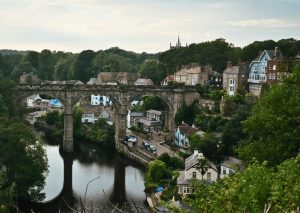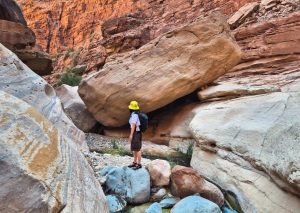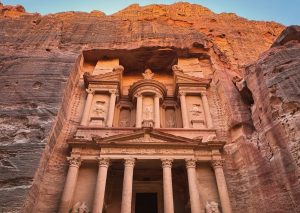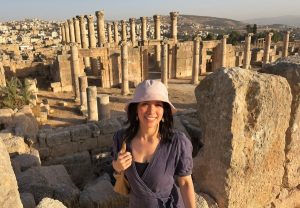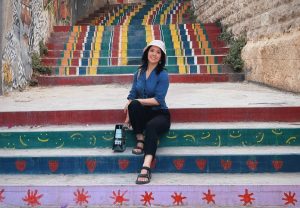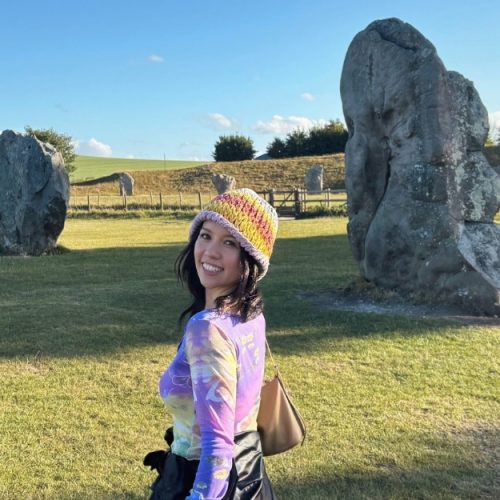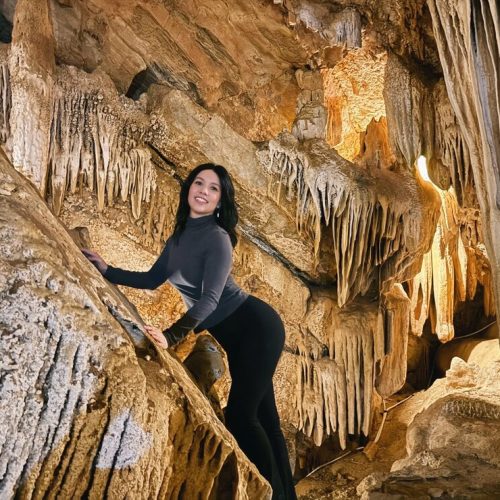
What can I say about Petra that hasn’t been said before? The first time I ever visited Petra it blew my mind. For years I dreamt about visiting again but I worried that it might have changed too much, that it might have become too overcrowded and touristy, or that revisiting would spoil the memories that I cherished so deeply.
There’s always a slight worry that revisiting a place might not live up to the first time. To use Sade’s famous words, I feared that it might never be as good as the first time. However, thirteen years had passed and I couldn’t wait any longer so I booked my ticket to Jordan and waited in anticipation to see the place that had lingered so vividly in my memory.
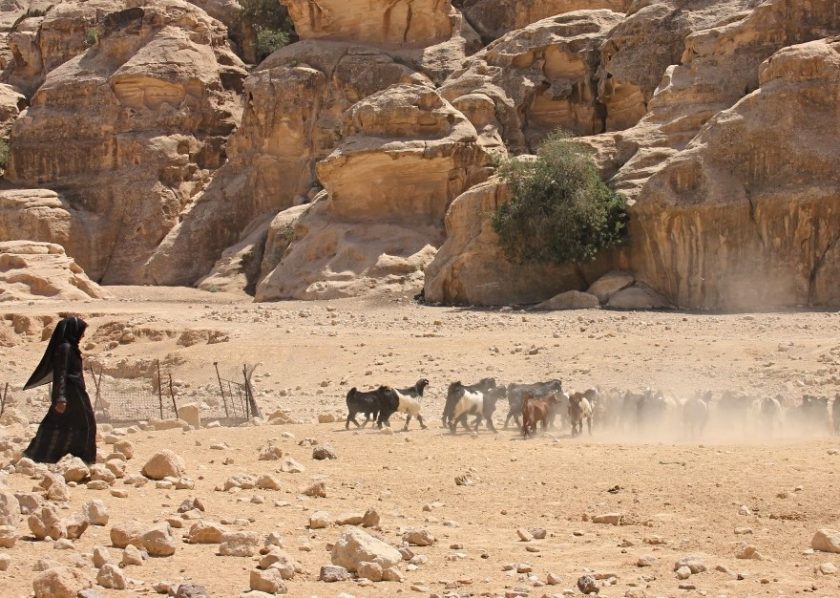
The beauty of Petra
Petra isn’t just a destination – there’s truly nowhere else like it on earth – it makes you feel like you have travelled back in time. You question how something so ancient, so improbable, could still exist in a world obsessed with the new. You question how something so monumental could be built before any of the modern building techniques and equipments even existed.
Recognised as one of the New Seven Wonders of the World, Petra is the crown jewel of Jordan – a city carved from rose-red cliffs that once guarded the secrets of an empire, and still carries an air of reverence, mystery, and awe.
This isn’t a neatly packaged wonder. Petra makes you work for it – through heat, dust, and the echoing canyon of the Siq, where every step brings you closer to a vision you can’t quite believe is real until you’re standing before it.
The Treasury, the Monastery, the tombs and temples – they aren’t just relics. They’re the bones of a lost world, half hidden, half revealed, still alive with the whispers of the Nabataeans who carved their city into the desert more than two thousand years ago.


A detailed guide to visiting Petra
Whether you come for the history, the beauty, or the mystery, Petra will get under your skin. It always does. This guide to Petra offers practical information, what not to miss, and includes some optional hiking routes if you have the time and energy. Make sure to pack plenty of water – you’ll need it!
How to get to Petra
There’s no airport in Petra itself, but both Amman Queen Alia International Airport and Aqaba King Hussein International Airport connect to most major regional hubs. From either, you can rent a car, hire a private driver, or catch the JETT Bus to Wadi Musa.
Wherever your starting point, all roads, quite literally, lead to Wadi Musa, the small town that serves as the modern gateway to the ancient city.
Getting to Petra from Amman
The majority of people will probably set off from Amman to Petra so here’s a detailed breakdown of transport options from the capital.
Distance: ~230 km
Time: Around 3–4 hours by car
Best Route: Take the Desert Highway (Highway 15) for the fastest and most direct option. If you’ve got time, the King’s Highway offers a far more scenic route – winding through canyons, olive groves, and small villages, with stops at Madaba, Mount Nebo, and Dana Biosphere Reserve along the way.
By Bus: The JETT Bus runs daily between Amman (Abdali Station) and Petra/Wadi Musa. It’s clean, reliable, and affordable — leaving 7am and arriving at 10.15am. You can book tickets through Busbud. Currently in 2025 tickets are approx £20 one way.
By taxi: If you are travelling with two or more people it might be just as cost effective to go by taxi. One way expect to pay around 75 -85 JD.
Get the Jordan Pass
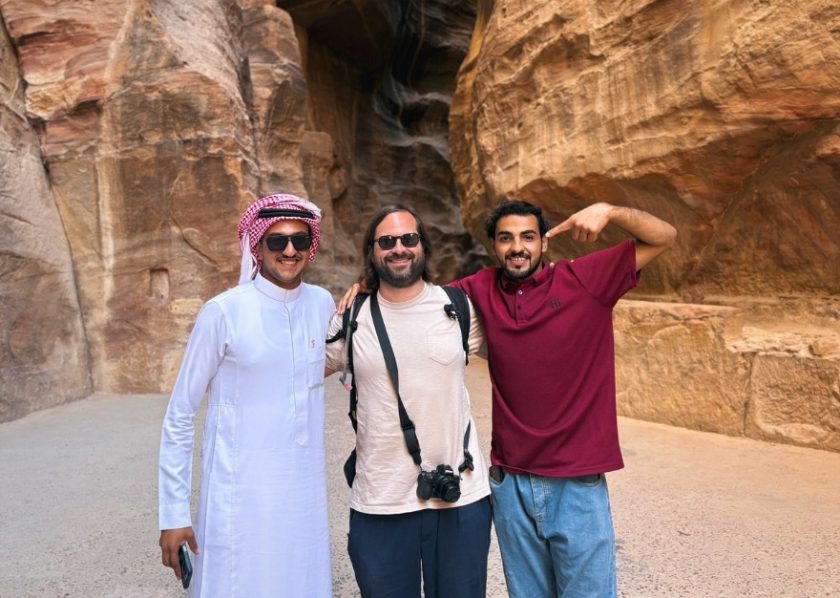
The Jordan Pass didn’t exist when I first went to Jordan, it launched in 2015 and it’s a really great addition to the ease of travelling within the country. There are a number of benefits to getting it but mainly it issues you with a free visa and entry to many attractions, including Petra.
Given the fact that a visa costs 40 JD and a one-day pass to Petra costs 50 JD, it more than pays for itself. So if you intend to visit Petra it’s already worth it, and anything else is a bonus. There are still some attractions that are not included, but major attractions like the Roman ruins of Jerash and several museums in Amman are all included. Once you total these up, you end up saving a lot of money.
Practical tip: When using your Jordan Pass, you may need to prove your identity by showing your passport, so be sure to bring it along. Sometimes they ask you for ID and sometimes they don’t, so bring it along just in case.
Here are the current Jordan Pass prices:
- Jordan Wanderer: Price 70 JD; one day in Petra
- Jordan Explorer: 75 JD; two consecutive days in Petra
- Jordan Expert: 80 JD; three consecutive days in Petra
Since the most expensive pass is only 5 JD more than the Explorer (that’s the equivalent of £5 / $6.50), I opted for that one. I knew I wanted to spend 2 or 3 days in Petra so going for the 3 day pass gave me that extra day in case I needed it.
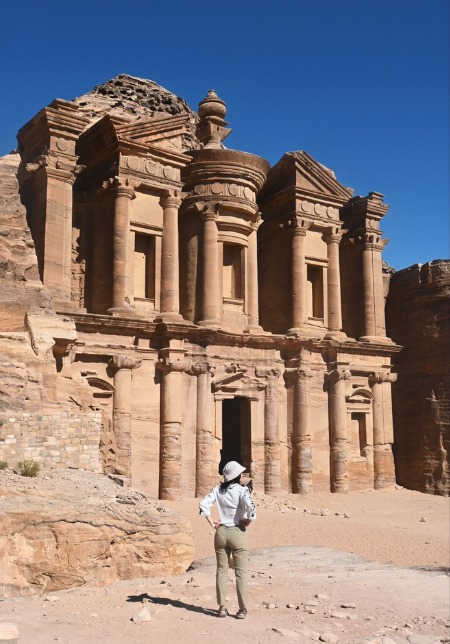
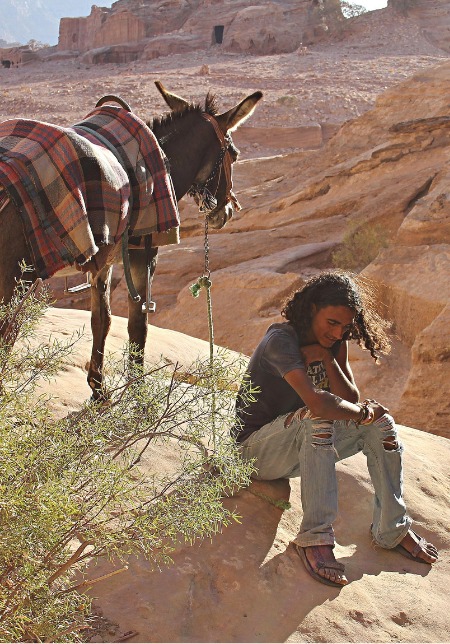
Must-see places in Petra Archeological Site
As I was walking around Petra, I overhead a woman saying that she had no idea that there was so much more to see beyond the Treasury. She was saying it in a positive way, with total amazement, as though Petra had exceeded all her expectations. And it really does. It’s huge.
Maybe because I had visited before, or maybe because I probably had researched the hell out of the place before visiting, but it sort of surprised me that some people visit Petra without realising that there is so much more to see beyond its most famous site: the Treasury.
Due to its scale, and the fact that you can easily rack up 30,000 steps in one day, I want to show you some of the places you should head to during your trip to Petra. It would be a shame to go there and miss some of the other monuments simply because you didn’t know they existed.
Most of these sites fit into a chronological order if you begin from the entrance and walk all the way up to the Monastery. However, there are some sites like Little Petra and the Place of High Sacrifice that are away from the main walking trails and require a bit more time and energy to reach.
The siq

After picking up your tickets from Petra Visitor Center, take the path (Bab Al-Siq) for about 10 minutes before you enter the Siq, a narrow, winding gorge about 1.2 km long. The towering cliffs rise almost vertically on either side, coloured in shades of red, pink, and orange.
Walking through the Siq feels monumental, the whole thing is like a movie set. I could literally feel the anticipation brewing within me, knowing that soon enough I’d be standing face to face with the Treasury.
The Treasury

At the end of the Siq, the gorge opens suddenly to reveal Al-Khazneh, Petra’s most iconic facade. Carved out of the rose-red sandstone, the Treasury is a masterpiece of Nabataean engineering and artistry. Take your time here – let the scale, detail, and history sink in. This is the spot that makes Petra a “new wonder of the world.”
Street of Facades

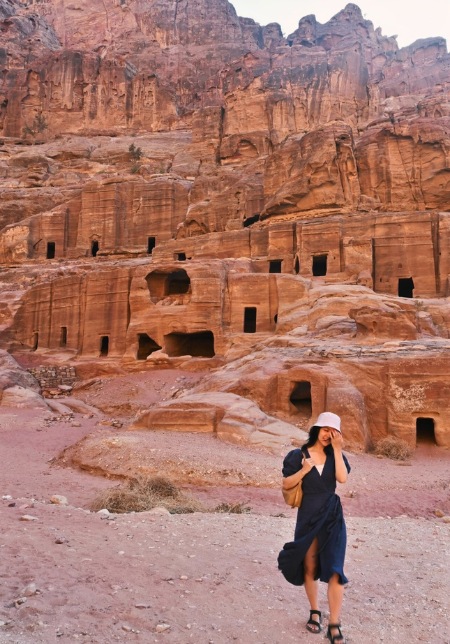
From the Treasury, continue along the Street of Facades, a row of tombs and monumental facades carved into the cliffs. This is a quieter area to wander and absorb the craftsmanship and urban planning of the ancient Nabataeans. Each facade has its own story, blending Hellenistic, Roman, and indigenous influences.
Tip: Unlike some of the bigger monuments like The Treasury and the Monastery, you can go inside these tombs.
The Theatre

Next up is the Roman-style theatre on your left, carved directly into the mountainside. It could seat up to 3,000 spectators and highlights the Nabataeans’ ability to blend functionality with grandeur. Even today, it’s easy to imagine crowds gathered here centuries ago for performances or gatherings.
On a side note, if you’re interested in seeing more roman architecture in Jordan, make sure to factor a trip up to Jerash. It’s one of, if not the more well-preserved Roman ruins across the whole of the Middle East.
Royal Tombs
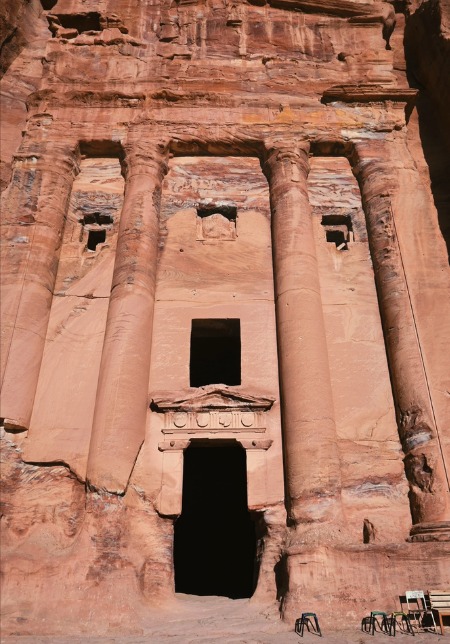
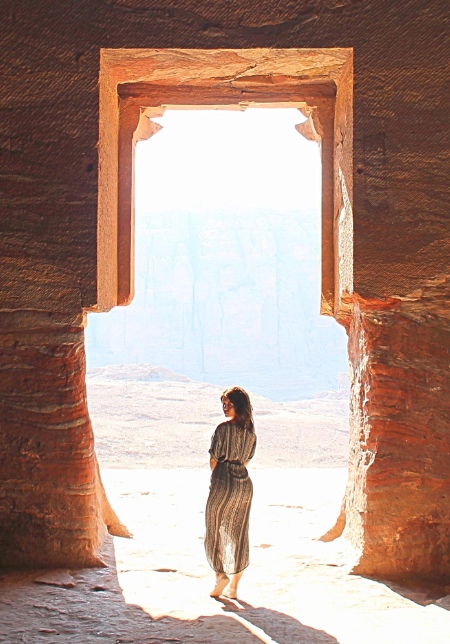
Opposite the Theatre, on your right, climb up to the Royal Tombs, a cluster of monumental tombs including the Urn Tomb, Silk Tomb, and Corinthian Tomb. The views from here are breathtaking. The city spreads below you, framed by mountains in the background.
This section gives a sense of Petra’s scale, wealth, and reverence for the afterlife. The tombs are empty, but the natural red marbling in the stone is stunning.
Colonnaded Street & Great Temple
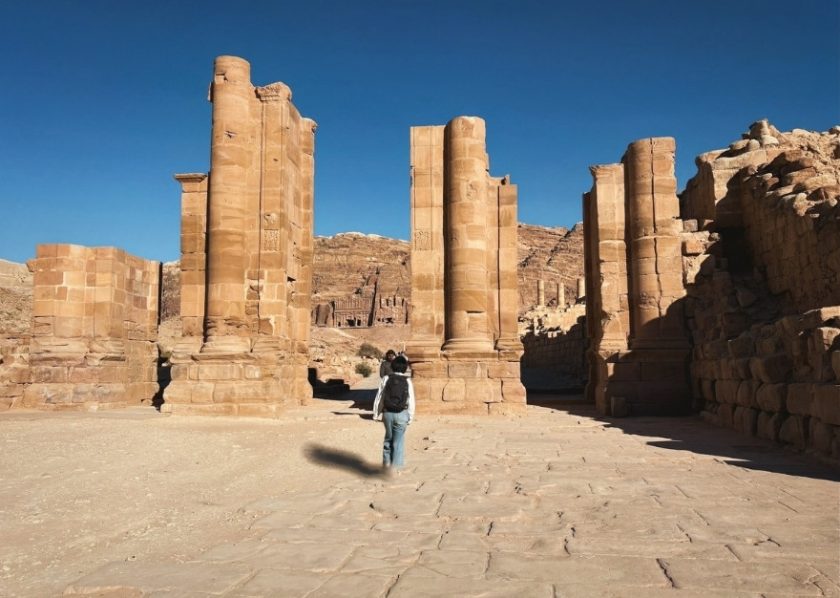
Once you’re back to ground level, pick up where you left off on the main path until you reach the Colonnaded Street. This once formed the heart of Petra’s commercial and ceremonial life.
Stop at the Great Temple, an impressive structure showcasing monumental Nabataean architecture. These areas reveal the city’s daily rhythms and social life – a contrast to the tombs and facades that you’ve seen earlier.
Take a break: Just up from the Great Temple is a nice resting spot with toilets and a cafe serving refreshments and snacks. It’s about 850 uphill steps up to the Monastery from here so now is a good time to refuel.
The Monastery (Ad-Deir)

Finally, the grand finale: the Monastery. Congratulations on making it this far! In total, from the entrance of the Siq it takes around 1.5 hours to get here (not including a detour to the Royal Tombs), but in reality with all the photo stops and whatnot it can take a lot longer. The final 850 steps takes around 30 minutes.
This enormous façade rivals the Treasury in scale and majesty. Carved from the sandstone cliffs, the Monastery feels remote, almost otherworldly – the perfect conclusion to your journey through Petra. Pause here, take a refreshment from the kiosk, and watch the sunlight transform the rock as you imagine life in the Nabataean kingdom.
If your feet aren’t too tired, explore the surrounding area. Behind the kiosk you will find a backdrop of expansive canyons that seemingly go on forever. If nature if your thing it’s worth the short walk over.
Take it easy going heading back down the way you came. At least it’s all downhill now!
Optional places to visit in Petra (for the adventurous)
These places deviate from the Main Street so they require extra time and energy to visit. I would included these sites only if you are planning to be in Petra for 2 or more days.
High Place of Sacrifice
If you’re up for a steep hike, head to the High Place of Sacrifice, a mountaintop altar once used for rituals. The climb is rewarding: panoramic views of Petra’s valleys and monuments, plus the chance to see carved altars and water channels. It’s a steep climb from the theatre / street of facades area.
Little Petra (Siq al-Barid)

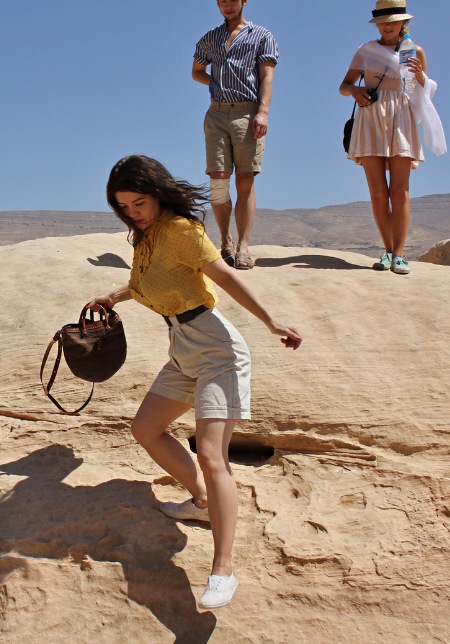
Just 6-km north of the main site, Little Petra is like a microcosm of Petra, of you could say, a baby version. The story goes that Little Petra served as a caravanserai, a kind of rest stop for traders carrying spices, silk, and incense along the great trade routes.
The narrow gorge opens to carved facades and caves, some still showing faint frescoes of vines and birds — rare traces of Nabataean art. From here, the back trail to the Monastery begins, winding through wild sandstone hills until it meets Petra’s grandeur.
If you like hiking, the 7-km hike from Little Petra to the Monastery is incredible. It’s my favourite hike in the whole complex but does require some scrambling so you’ll need to wear decent footwear if you decide to do it. While I did the whole trek on foot, nowadays there is a 4×4 option which can drop you off closer to the monastery. This wasn’t an option when I did the hike many moons ago, and turns the ordinary 3 – 3.5 hike to around an hour or so.
Most travellers skip Little Petra. But in its silence, its rough beauty, you catch a glimpse of the world that made Petra possible – humbler, older, and just as unforgettable.
Petra Museum: framing a lost civilisation

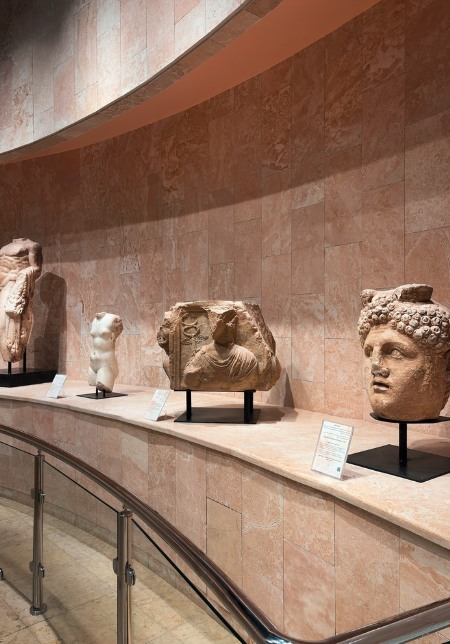
The museum only opened in 2019, it didn’t exist during my first trip to Petra so I was happy to visit this new addition. It does an excellent job putting this whole complex into content, so if you have time, it’s probably best to visit before you explore the archaeological site. Admittedly it’s hard to resist making a bee-line straight for the Siq, so I wouldn’t blame you if you decided to visit afterwards! Either way, do try and visit.
It’s located in a modern building just beside the visitor centre. It’s the kind of place that quietly deepens your understanding before the main act begins.
Inside, light filters through the space, illuminating artifacts that trace 10,000 years of human history in the region – from Neolithic farmers to Nabataean traders. You’ll find intricately carved pottery, coins, sculptures, and the tools that built an empire from desert rock. Models and interactive displays bring the city to life, showing how the Nabataeans channelled water through sandstone and carved temples into cliffs that still defy time.
You’ll also discover how Petra was influenced from the Greek and Roman civilisation which came as a surprise to me. It’s fascinating to see how much the Nabateans absorbed many Greek and Roman aesthetic ideas. You can even spot this interplay today on monuments like the Treasury.
Where to Stay in Petra
On my most recent trip to Petra I stayed at the lovely Infinity Lodge. The setting is intimate with just a few rooms all designed with character and quality. Each room has a balcony overlooking the city and the mountains in the distance.
The food which they serve from their terrance every evening reflects flavours from the region. Some of the best food I had during my entire trip. It’s also conveniently located about a 15-minute walk to the Petra ticket centre. All the staff are super friendly and happy to answer any questions and queries you might have.
Final thoughts
I’ve been to lucky to visit an array of incredible places around the world, and I can say without hesitation that Petra is one of the most inspiring. If you’re been to Angkor Wat, it’s right up there with that archaeological site in terms of magnitude and awe-inspiring craftsmanship (only with far less crowds!)
This huge once forgotten complex stands at the crossroads of civilizations – a Nabataean city built with Greek artistry and Roman engineering. It’s what makes it so extraordinary: not a pure culture, but a fusion – desert ingenuity meeting Mediterranean elegance.
You might also like:


